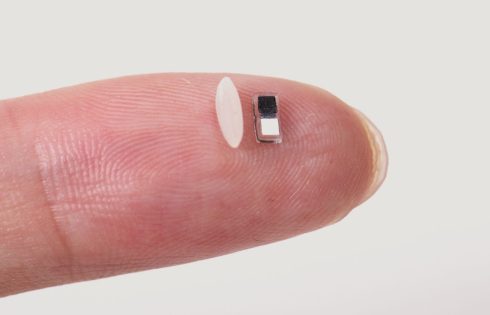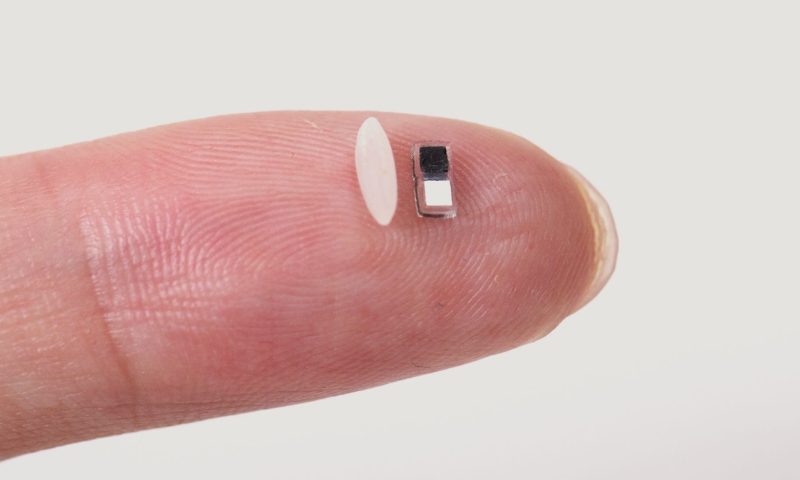
A dissolvable pacemaker that’s smaller than a grain of rice and powered by light could become an invaluable tool for saving the lives of newborn infants., The device can be implanted noninvasively via syringe, and may also be useful for adult patients dealing with certain heart defects. The medical breakthrough is detailed in a study published April 2 in Nature.
Roughly one percent of infants are born with heart defects every year. The majority of these cases only require a temporary implant for about seven days to allow time for the heart to naturally self-repair. But for low-resource regions of the world lacking access to advanced medical care, what should be a simple procedure can often end in tragedy. Meanwhile, the current standard for temporary pacemakers in adults also presents difficulties. Most procedures involve surgeons sewing electrodes directly onto the heart, then attaching those electrodes to an external pacing box using wires that exit a patient’s chest. Doctors remove the electrodes once they are no longer needed, but post-surgery risks include infection, damaged tissue, dislodgment, and blood clots. The wires sometimes also become encased in scar tissue, presenting further complications.
“That’s actually how Neil Armstrong died. He had a temporary pacemaker after a bypass surgery. When the wires were removed, he experienced internal bleeding,” experimental cardiologist and study co-lead Igor Efimov explained in a statement.
In 2021, a Northwestern University team including Efimov unveiled a quarter-sized, biodegradable temporary pacemaker without cumbersome batteries, rigid components, or wiring. The device relies on near-field communication protocols similar to those used in RFID tags and smartphones to complete electronic payments. For this to work, however, the pacemaker needed to include a built-in antenna to relay radio frequency commands.
“Our original pacemaker worked well. It was thin, flexible and fully resorbable. But the size of its receiver antenna limited our ability to miniaturize it,” said its co-creator and bioelectronics pioneer John Rogers.
Rogers, Efimov, and collaborators spent the next few years researching ways to shrink their temporary pacemaker to even smaller proportions. They eventually realized they could swap out the radio antenna for a design that instead relies on light-based data transmission. They also replaced the original device’s near-field communication power source with a galvanic cell—a type of battery that converts chemical energy into electrical energy. In the new version, the pacemaker relies on two metal electrodes that generate an electrical current after interacting with surrounding biofluids. This current is then directed to stimulate and regulate the heart through a miniscule, infrared light-activated switch installed on the battery’s opposite side.
“Infrared light penetrates very well through the body,” said Efimov. “If you put a flashlight against your palm, you will see the light glow through the other side of your hand. It turns out that our bodies are great conductors of light.”
Because the human heart requires only a small amount of electrical stimulation, researchers were able to shrink their next-generation pacemaker even smaller. The final result is a 1-millimeter-thick device measuring just 1.8 mm wide and 3.5 mm long that is still capable of delivering as much electrical stimulation as a standard pacemaker.
“We have developed what is, to our knowledge, the world’s smallest pacemaker,” Rogers said.
Given its materials safely dissolve over time, the pacemaker also doesn’t require any follow-up invasive surgery to remove it. This dramatically cuts down on the potential for post-op complications and trauma.
But why stop at just one miniature pacemaker? Efimov, Rogers, and collaborators believe that further advancements could allow the deployment of multiple devices across the heart. Once implanted, designers could coordinate them to move independently or together based on specific light wavelengths. This could lead to more complex synchronization therapies, including those that treat arrhythmias.
“We also could incorporate our pacemakers into other medical devices like heart valve replacements, which can cause heart block,” suggested Efimov.
The device’s size also means it can be incorporated into other implantable tools such as transcatheter aortic valve replacements, pain inhibitors, as well as nerve and bone restoration techniques. These future possibilities, however, all trace back to the team’s original goal.
“Our major motivation was children,” said Efimov. “Now, we can place this tiny pacemaker on a child’s heart and stimulate it with a soft, gentle, wearable device.”

